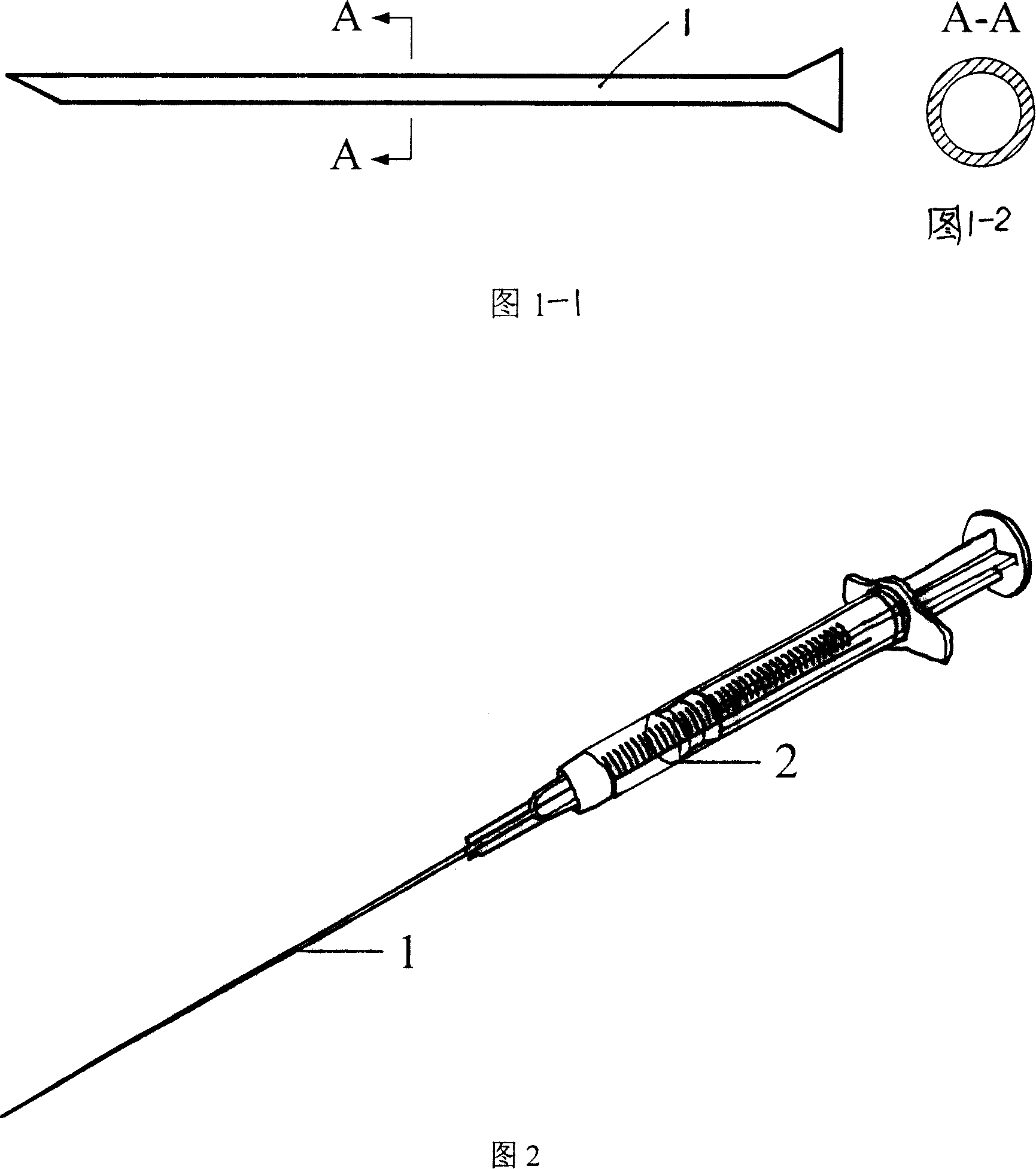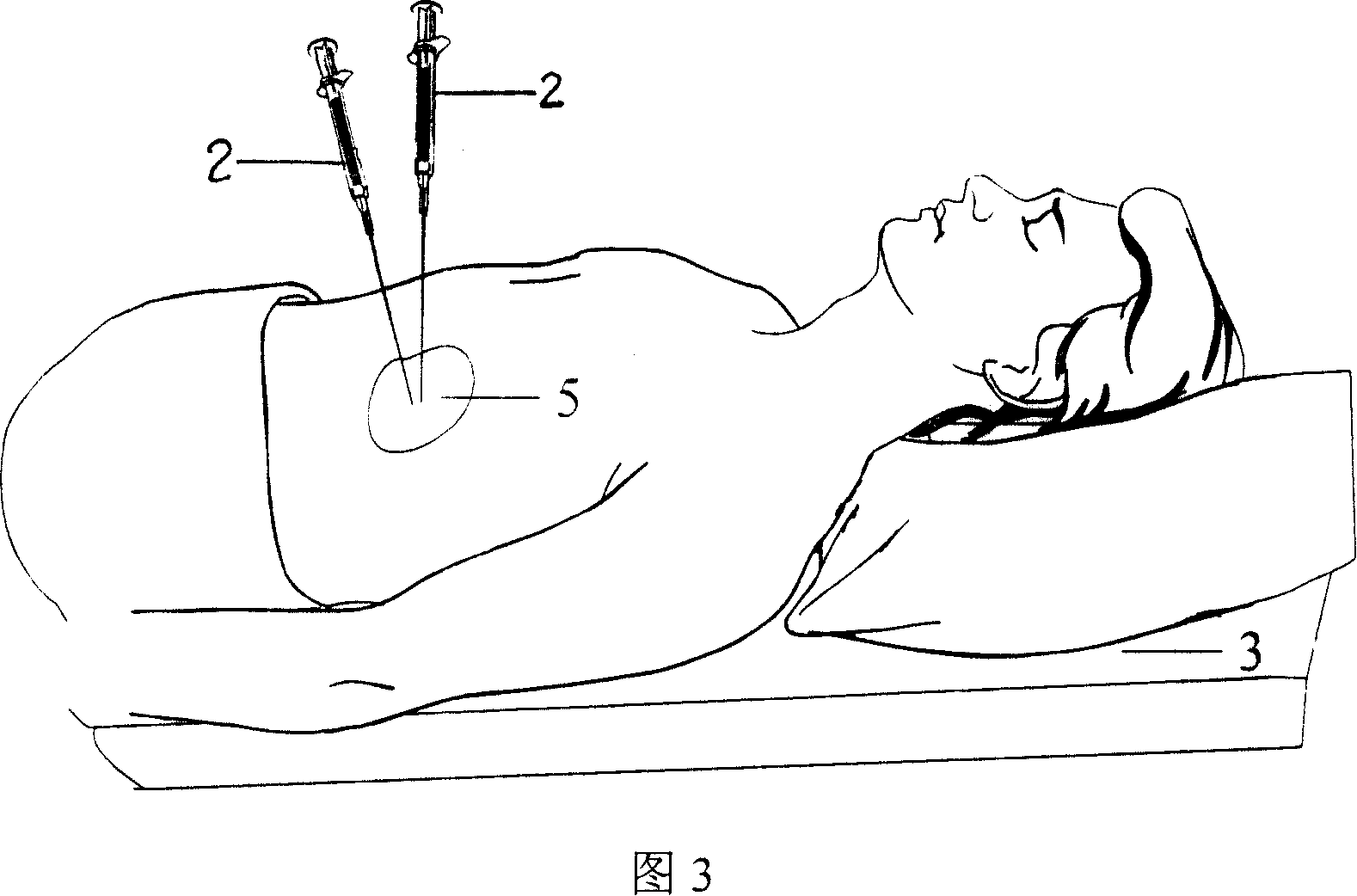Knub thermotherapy based on exothermic chemical reaction
A chemical reaction and tumor technology, applied in the field of tumor hyperthermia, can solve the problems of incompetence, high price, difficult operation, etc., and achieve the effect of reducing thermal damage and easy operation.
- Summary
- Abstract
- Description
- Claims
- Application Information
AI Technical Summary
Problems solved by technology
Method used
Image
Examples
Embodiment 1
[0039] Fig. 1-1 is a schematic diagram of an interventional injection device used in the present invention; Fig. 1-2 is a cross-sectional view of A-A of Fig. 1-1, wherein 1 is a puncture needle;
[0040] Fig. 2 is a schematic structural view of the injection device in Fig. 1; wherein 1 is a puncture needle, and 2 is a syringe;
[0041] Fig. 3 is a schematic diagram of implementing the exothermic chemical reaction-based tumor hyperthermia method of the present invention; wherein 2 is a syringe, 5 is a tumor target tissue, and 3 is an elevating bed.
[0042]Concentrated hydrochloric acid and sodium hydroxide solutions are selected as the liquid reactants for injection, so that two solutions need to be injected into the target tissue. The feasibility of this embodiment is illustrated by calculation below:
[0043] Inject 100 grams of 40% NaOH solution and 100 grams of 37.5% concentrated hydrochloric acid into the target tissue, so that a total of 200 grams of the solution is inj...
Embodiment 2
[0051] The reactants are selected from concentrated hydrochloric acid and sodium hydroxide solution.
[0052] Inject 100 grams of NaOH solution with a mass percent concentration of 40% and 150 grams of concentrated hydrochloric acid with a mass percent concentration of 37.5% to the target tissue respectively, so that a total of 250 grams of the solution is injected into the tumor target tissue, then It is still reasonable to think that this part of the heat release is concentrated in 1000 grams of tissue. The molar ratio of concentrated hydrochloric acid and sodium hydroxide injected in this example is 1.5:1. After the reaction, hydrochloric acid remains in the tissue, but hydrochloric acid is a substance existing in the human body (such as gastric acid contains hydrochloric acid), so it will not It is harmful to the human body, and hydrochloric acid also has a certain killing effect on tumor cells through chemical effects.
[0053] It can be seen from Example 1 that in this ...
Embodiment 3
[0058] The reactants are selected from concentrated hydrochloric acid and sodium hydroxide solution.
[0059] Inject 100 grams of 40% NaOH solution and 200 grams of 37.5% concentrated hydrochloric acid into the target tissue, so that a total of 300 grams of the solution is injected into the tumor target tissue. It is still reasonable to concentrate part of the heat release in 1000 grams of tissue. The molar ratio of the concentrated hydrochloric acid and sodium hydroxide injected in this example is 2:1. After the reaction, hydrochloric acid remains in the tissue, but hydrochloric acid is a substance existing in the human body (such as gastric acid contains hydrochloric acid), so it will not It is harmful to the human body, and hydrochloric acid also has a certain killing effect on tumor cells through chemical effects.
[0060] It can be seen from Example 1 that in this case, 57.32 kJ of heat will be released into 1000 grams of tissue and 300 grams of solution after the reacti...
PUM
| Property | Measurement | Unit |
|---|---|---|
| The inside diameter of | aaaaa | aaaaa |
| Length | aaaaa | aaaaa |
| Length | aaaaa | aaaaa |
Abstract
Description
Claims
Application Information
 Login to View More
Login to View More - R&D
- Intellectual Property
- Life Sciences
- Materials
- Tech Scout
- Unparalleled Data Quality
- Higher Quality Content
- 60% Fewer Hallucinations
Browse by: Latest US Patents, China's latest patents, Technical Efficacy Thesaurus, Application Domain, Technology Topic, Popular Technical Reports.
© 2025 PatSnap. All rights reserved.Legal|Privacy policy|Modern Slavery Act Transparency Statement|Sitemap|About US| Contact US: help@patsnap.com



